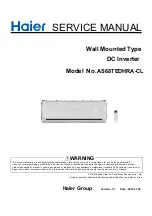
MS - SOUND decoders MS440 to MS990 and MN - NON-SOUND decoders MN170 to MN340 Page 53
CV
Denomination
Range
Default
Description
also see
CV #312
in this table
(Blow off
Key)
=
0 - 25 sec
up to the engineer. An automated draining at start-
up is more suitable in model railroading; CV #272
defines how long after start-up the blow-off sound
should play.
Value in CV #272 = time in tenths of a second!
Note: If the blow-off sound is also allocated to a
function key (as delivered on F4, see CV #312), the
automated blow-off sound can be shortened or ex-
tended with the relevant function key. Automated
blow-off and function key blow-off are inevitably the
same (as per selection/allocation).
= 0
: no blow-off sound playback
#273
Blow-off-
Start-up delay
0 - 255
=
0 - 25 sec
1
0
Opening the cylinder valves and with it the related
blow-off sound on a real steam engine starts most
often before the engine even starts to move. This
can be imitated with CV #273 by automatically de-
laying the start of the locomotive.
This effect is cancelled when a shunting function
with momentum deactivation is being activated
(see allocation of F3 or F4 in CV #124!)
= 0: no delayed start
= 1: Special setting blow-off by controller;
no delayed start, however, lowest speed
step (lowest slider position > 0, only for
128 speed steps) means “do not drive yet,
but blow off!”).
= 2 ... Start-up delay in tenths of seconds:
Recommendation: no values > 20 (> 2 sec)
#274
Blow-off-
Standstill
and
Starting whistle
Standstill
0 - 255
=
0 - 25 sec
30
Constant opening and closing of the cylinder valves
in real shunting operations, that often requires
many short trips with associated idle times, is usu-
ally omitted. CV #274 causes the blow-off sound to
be suppressed if the engine wasn’t standing still for
the time defined here.
Value in CV #274 = time in tenth of a second!
The same stop-time is also used for the start-up
whistle!
#312
Blow-off key
0 - 28
-
Defines function key which activates blow-off
noise; e.g.
for shunting with “open valves”.
#354
Chuff beat
frequency
at
speed step 5
also see
CV #267
in this table
1 - 255
11
CV #354 works only if used with CV #267!
CV #354 compensates for the non-linear speed
measurements of the “virtual cam sensor”:
While the adjustment of CV #267 is done in the vi-
cinity of speed step 20-30, a correction for speed
step 5 can be performed with CV #354 (extremely
slow).
= 0: no effect
= 1 - 127: Steam chuffs at speed step = 1 (and
extremely slow speed) more common than
CV #267
= 255 - 128: less chuff beats.
CV
Denomination
Range
Default
Description
#154
Various special bits
planned in
SW version 5.00 and
higher
16
Bit 1 = 1: DIESEL, ELECTRO Drive off immedi-
ately even if playback of idle sound has not yet
finished.
Bit 2 = 1: DIESEL, ELECTRO After short stops,
wait for idle sound before driving off.
Bit 4 = 1: STEAM: Two stage compressor (Z1 for
fast refill after coming to a stop, Z2 for slow pres-
sure loss compensation during longer stops).
Bit 7 = 1: Delay start until playback of start-up
whistle has finished.
Other Bits: OEM special features
(Loco with pantograph, etc.)
#158
Various special bits
Bits 1, 3, 5, 6, 7
(only DIESEL & ELEC-
TRO):
SW version 5.00 and
higher
-
0
Bit 1 = 1: Diesel mechanical: RPM is not raised
when braking (see CV #364)
.
Bit 3 = 1: (DIESEL) Sample for standstill is
faded out when driving-
off “early”.
Bit 4 = 1: Steam chuff frequency increases slower
at high speed (non-proportional)
Bit 5 = 1: (DIESEL) Braking (even by one speed
step) causes the motor and turbo
sounds to decrease by on sound step.
Bit 6 = 1: (ELECTRO) Thyristor sound may be
louder when braking.
Bit 7 = 1: (ELECTRIC) Switchgear sparks on FO7.
#393
ZIMO
special
configuration
bits „5“
Bit 0 = 1: Activates ditchlight when bell plays
Bit 1 = 1: Activates ditchlight when horn plays
Bit 2 = 0: Always start with the 1st sample of the
high-speed gear shift
= 1: Play one sample after the other
Bit 3 = 0: When shifting up, play beginning and
end part (Only the middle part when
shifting down).
=1: Also when shifting up, skip start and end
part (as with shifting down).
Bit 4 = 1: Do not raise thyristor2 pitch.
Bit 5 = 1: Switch SUSI to reed inputs
Bit 6 = 1: 4x extend chuff beat interval
Summary of Contents for MS450
Page 5: ...MS SOUND decoders MS440 to MS990 and MN NON SOUND decoders MN170 to MN340 Page 5...
Page 61: ...MS SOUND decoders MS440 to MS990 and MN NON SOUND decoders MN170 to MN340 Page 61...
Page 85: ...MS SOUND decoders MS440 to MS990 and MN NON SOUND decoders MN170 to MN340 Page 85...
Page 87: ...MS SOUND decoders MS440 to MS990 and MN NON SOUND decoders MN170 to MN340 Page 87...
Page 88: ...Page88 MS SOUND decoders MS450 to MS990 ZIMO Elektronik GmbH Sch nbrunner Str 188 A 1120 Wien...
















































